Kuwait, along with most developing nations, has seen its growth restricted by crippling traffic jams. As with other major problems in Kuwait, it has been worsening exponentially because of a total lack of planning and forethought. We at re:kuwait will not wait any longer and are proposing our own solutions.
At the heart of it, the problem is simple. There are too many cars on the road. Therefore, the solutions will either be to reduce the number of cars or to build more roads. For years, traffic problems in the United States have seen them invest heavily into building more and more highways. The problem with this is that more highways will eventually generate increased demand for cars. This will clog up all the new highways and the traffic persists. This is not a solution for Kuwait, not only because it doesn’t really solve the traffic problem, but that we simply don’t have the room to build new highways where they’re needed.
It becomes clear then that the only solution is to reduce the demand for cars and provide alternate means of transportation. This won’t be easy, as the status-quo will be defended by highway contractors, automobile dealers and the services that depend on them.
We have to be persistent and fight back by arguing that reducing traffic not only ensures a better economy and quality of life but will lower our overall carbon emissions and reduce our domestic consumption of oil. This requires a comprehensive solution. There are six ways we can lower automobile demand:
1: Abolish the fuel subsidy. Kuwait sells gasoline to the gas stations at a much lower price than its market value. This is called a subsidy, which means that the government is subsidizing (lowering) the price of gasoline for its citizens. Our government does this to alleviate the cost burden from its citizens. A fuel subsidy is in place in many developing countries as well as in almost all oil exporters.
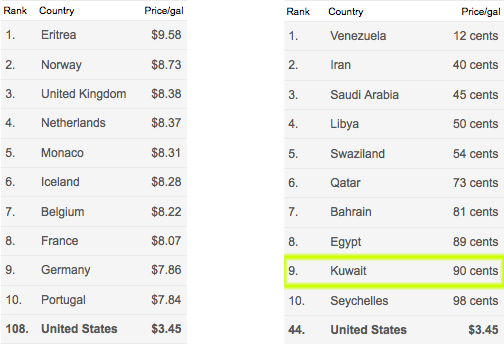
As you can see, Kuwait sells its gasoline at around 1 dollar per gallon. Germany and other developed (and oil importing) nations sell gasoline 7 or 8 times the price in Kuwait. They do the opposite of us, they tax the fuel that is sold in gas stations. This reduces the demand for driving by artificially increasing the price. I’m not suggesting that we implement a fuel tax, but that we should simply abolish the subsidy. This means that the Kuwait Oil Company is not losing money by selling domestic oil at a loss while also reducing automobile demand. The revenue generated by this would be reinvested into alternate means of transportation as well as an increase in wages. This would cause some inflation, but the reduced traffic would more than make up for that by increasing productivity.
2: Provide alternate transportation modes. What are the alternatives to driving in Kuwait? To get from point A to B you have very little choice but to drive. Our suburban residential areas were designed to only be accessible by automobiles. The bus system has gotten a lot better these past few years, but they suffer just as much as cars in traffic. We need several new modes of transportation that overlap and provide alternatives so people can use the modes that appeal to them and provide the least resistance. The only way this would work is if driving becomes so unappealing that people would be willing to use mass transit. Right now, I believe we have reached this tipping point. Let’s imagine that the Kuwait Metro has been built and that the stations are well designed and strategically placed. People would begin to gradually alter their living, work and transportation patterns. Workplaces close to a Metro station would become more desirable. Residential projects will advertise that they are a walking distance from a Metro station. People would mix up their transportation routes, driving to a station, parking their car and using the Metro the rest of the way.
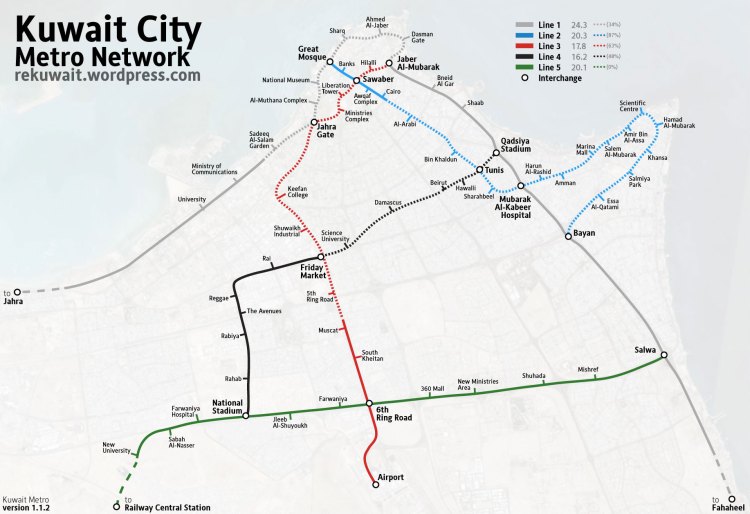
The only way the Metro would be successful is if the stations are placed very close together in the dense areas (Salmiya, Hawalli, the City, etc). It has to be a comfortable 5 minute walk from one station to the next. This creates a network in the dense areas where every location is walking distance away from a transportation node. This would mean that having a car in these areas is entirely optional. You do not have to have a car to live. The suburbs would be served with massive Park and Ride stations around the perimeter (and one in the center) of the residential areas. On the Metro map above, these stations are Bayan, Mishref, Shuhada, 5th Ring Road, 6th Ring Road and Damascus. Every mall, university campus and major hospital would have a Metro station that would link them to the system. This project is essential to the progressive development of our nation and its implementation should not be delayed.
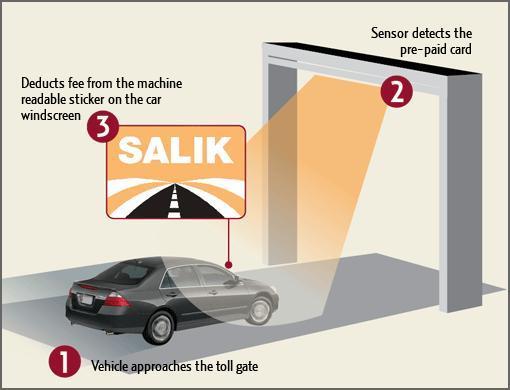
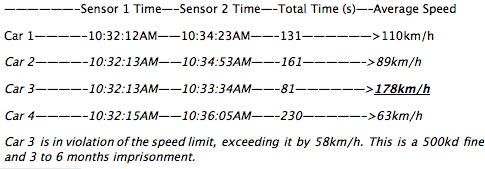
-Congestion Charge.
4: Fuel cost stickers. A new law should be implemented that requires a sticker to be placed on every car in every showroom showing the average amount of money the owner would be expected to pay in fuel costs per year. MPG is incomprehensible for most buyers and hides the true cost. It seems arbitrary and is hard to quantify. When a prospective buyer compares two cars they would instantly be able to see the different fuel costs involved. For example, on one side an SUV that would cost 2000KD per year and on the other a hybrid that costs 300KD per year. The buyer would add this cost to the final sticker price and make a much more informed decision. This would add a visible incentive for buying more fuel efficient cars. This demand would also mean that car dealers would import more fuel efficient cars and market them aggressively. We consume less gasoline and export more crude oil. Everybody wins.
5: Migratory traffic. The way the urban plan of Kuwait City was devised has created large districts that are very specialized. This high degree of segregated zoning creates innumerable social, cultural and transportation problems. The Business district are evacuated after work hours. The Entertainment districts flooded on weekends. There is no quick solution to this problem. What is required is a sustained effort to decentralize Kuwait and create more mixed use development which would fragment the city and allow for a less predictable traffic and transportation network. We have to educate the relevant authorities that strict zoning laws and suburban sprawl create far more problems than they solve. We need to start rethinking how we organize Kuwait City.
6: Raise the driving age to 21. Our population is growing fast. More and more young people are reaching 18 years of age and will be eligible to drive. Most fatal traffic accidents are unfortunately a result of reckless driving by 18 year old boys (or younger).
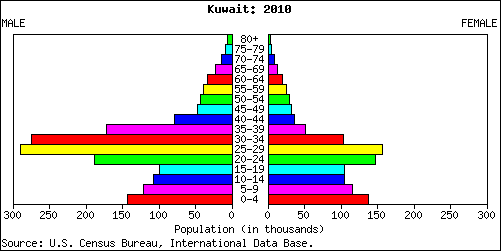
This diagram shows the expected population pyramid for Kuwait in 2010. The spikes in the population between 20 and 45 years is due to our foreign labor population. Removing these spikes would make our pyramid look something like this:
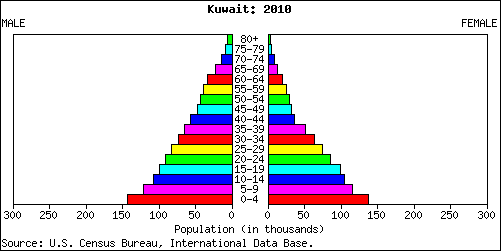
As you can see, the base of the pyramid is growing every year. This means that every year, more babies are being born than the year before. Our population is expanding. Increasing the driving age by three years would very quickly lower the number of new cars on the road. An obvious benefit is that 21 year olds would be a little more mature and would not drive as recklessly, making our roads safer and saving lives. Students would complain that they have to go to university and they can only drive there. Seeing how they complain about the traffic and parking problems on campus, this might benefit them as well. I believe that Kuwaiti students have an unjustified sense of entitlement and many will reject the idea that they have to be driven to campus, or find other ways to get there. If you really have a problem, you can live on campus. You can use the metro to get to class. Students have been driven to school from kindergarten through high school. Why stop there? Of course, this simply delays the problem. In three years the students will all start driving. This three year delay will give us time to implement most of the solutions. Seeing as how our population is increasing exponentially, we need to solve the problem as quickly as possible.
In conclusion, it becomes increasingly clear that simply making driving less desirable will not solve the problem and only inflict additional suffering. We have to provide an alternative to driving. The effect of abolishing the fuel tax, creating a new RFID speed limit system, raising the driving limit and so on is punishing. It would only make sense if people can reject the driving option and choose a far more desirable mode of transportation. The alternative would be to use the Metro, carpooling, riding the bus, or simply driving less. What this means is that there are less cars on the road with people maintaining a higher quality of life. We have to make the car optional. Only then would we see the end of our traffic nightmare.
LWDLIK - So what's the hold up in implementing all this? Bravo re:kuwait for taking the initiative, let's hope someone listens. Love the Salem Mubarak Street pedestrian proposal too [link].
At the heart of it, the problem is simple. There are too many cars on the road. Therefore, the solutions will either be to reduce the number of cars or to build more roads. For years, traffic problems in the United States have seen them invest heavily into building more and more highways. The problem with this is that more highways will eventually generate increased demand for cars. This will clog up all the new highways and the traffic persists. This is not a solution for Kuwait, not only because it doesn’t really solve the traffic problem, but that we simply don’t have the room to build new highways where they’re needed.
It becomes clear then that the only solution is to reduce the demand for cars and provide alternate means of transportation. This won’t be easy, as the status-quo will be defended by highway contractors, automobile dealers and the services that depend on them.
We have to be persistent and fight back by arguing that reducing traffic not only ensures a better economy and quality of life but will lower our overall carbon emissions and reduce our domestic consumption of oil. This requires a comprehensive solution. There are six ways we can lower automobile demand:
1: Abolish the fuel subsidy. Kuwait sells gasoline to the gas stations at a much lower price than its market value. This is called a subsidy, which means that the government is subsidizing (lowering) the price of gasoline for its citizens. Our government does this to alleviate the cost burden from its citizens. A fuel subsidy is in place in many developing countries as well as in almost all oil exporters.

As you can see, Kuwait sells its gasoline at around 1 dollar per gallon. Germany and other developed (and oil importing) nations sell gasoline 7 or 8 times the price in Kuwait. They do the opposite of us, they tax the fuel that is sold in gas stations. This reduces the demand for driving by artificially increasing the price. I’m not suggesting that we implement a fuel tax, but that we should simply abolish the subsidy. This means that the Kuwait Oil Company is not losing money by selling domestic oil at a loss while also reducing automobile demand. The revenue generated by this would be reinvested into alternate means of transportation as well as an increase in wages. This would cause some inflation, but the reduced traffic would more than make up for that by increasing productivity.
2: Provide alternate transportation modes. What are the alternatives to driving in Kuwait? To get from point A to B you have very little choice but to drive. Our suburban residential areas were designed to only be accessible by automobiles. The bus system has gotten a lot better these past few years, but they suffer just as much as cars in traffic. We need several new modes of transportation that overlap and provide alternatives so people can use the modes that appeal to them and provide the least resistance. The only way this would work is if driving becomes so unappealing that people would be willing to use mass transit. Right now, I believe we have reached this tipping point. Let’s imagine that the Kuwait Metro has been built and that the stations are well designed and strategically placed. People would begin to gradually alter their living, work and transportation patterns. Workplaces close to a Metro station would become more desirable. Residential projects will advertise that they are a walking distance from a Metro station. People would mix up their transportation routes, driving to a station, parking their car and using the Metro the rest of the way.

The only way the Metro would be successful is if the stations are placed very close together in the dense areas (Salmiya, Hawalli, the City, etc). It has to be a comfortable 5 minute walk from one station to the next. This creates a network in the dense areas where every location is walking distance away from a transportation node. This would mean that having a car in these areas is entirely optional. You do not have to have a car to live. The suburbs would be served with massive Park and Ride stations around the perimeter (and one in the center) of the residential areas. On the Metro map above, these stations are Bayan, Mishref, Shuhada, 5th Ring Road, 6th Ring Road and Damascus. Every mall, university campus and major hospital would have a Metro station that would link them to the system. This project is essential to the progressive development of our nation and its implementation should not be delayed.
3: Invest in RFID technology. RFID (Radio-Frequency IDentification) is an emerging field of technology where small amounts of information are stored on a cheap microchip which transmits that information through radio waves to an RFID scanner. Dubai has already implemented this technology to serve its toll booths by allowing cars to drive through the toll without having to stop to pay. Their system (called Salik) requires every car in Dubai to install an RFID sticker.

The sensor on the toll booth reads every car that passes underneath and deducts the fee from that drivers’ account. In Kuwait, we do not have a desperate need for toll booths, and implementing them would be counterproductive. We can use this technology for other purposes, such as:
-Replacing all the speed cameras with RFID sensors. An RFID system would have no way to measure the speed of a car as it rushes past. All it can do is scan the chip and download the License plate number and the exact time the car went past. A second RFID scanner further down the road does the exact same thing. A database would record the exact time each specific car has passed every scanner. The distance between Sensor 1 and Sensor 2 is divided by the time it has taken the car to go past them, revealing the average speed of the car. If the average speed is above the speed limit on that stretch of road, the driver would be fined accordingly. This is a completely automated system. Here is an quick example of how it would work:
Distance between Sensor 1 and 2 = 4km and the speed limit is 120km/h:

-Congestion Charge.
This is a flexible method for adjusting the cost of driving. It is similar to a toll booth in that it charges people to use the road, but it does not have a fixed value. In times of heavy traffic (rush hour) the charge would be highest. When traffic is low, the charge would be zero. This would force people to find alternate methods during rush hour and add more incentive to use mass transit and other means. The cost of using the road would be shown on the big automated signs that have been installed which currently serve little purpose. This system should only be implemented if the traffic is especially bad in a specific road and diverting commuters to other routes would solve the problem.
-Interactive online traffic map. Once the system is implemented it is possible to use the information to map real time traffic patterns. An interactive traffic map can be automatically generated and updated in real time. This would be published online so people can plan their routes. If possible, it would be integrated into car navigation systems so your route would be automatically adjusted based on traffic patterns. Software would be developed to create web and iPhone apps that take advantage of the open source traffic information. The technology exists in metro areas in the United States. This is not science fiction.
The variables are comparatively tiny and the vast number of calculations do not have to occur in real time. The RFID system only has to record the time and location while the calculations can be done remotely and at any time. This would be of immense benefit for the safety of commuters, as it would mean that reckless drivers can no longer simply slow down at each fixed camera and speed away once past. Anyone that has spent time in the rural areas of the United States would know that a similar method has already been in place for many years. One traffic cop would wait for a car to pass, and record the exact time on a stop watch. He would describe the car to his partner through his radio a kilometer or two down the road. His partner would use a stopwatch to record the time it takes for that car to go past him, and a quick calculation would reveal the average speed of the car, even if the driver slowed down when he saw the police car. It works really well, but unless the process is automated, it is impossible to implement in high density situations.
5: Migratory traffic. The way the urban plan of Kuwait City was devised has created large districts that are very specialized. This high degree of segregated zoning creates innumerable social, cultural and transportation problems. The Business district are evacuated after work hours. The Entertainment districts flooded on weekends. There is no quick solution to this problem. What is required is a sustained effort to decentralize Kuwait and create more mixed use development which would fragment the city and allow for a less predictable traffic and transportation network. We have to educate the relevant authorities that strict zoning laws and suburban sprawl create far more problems than they solve. We need to start rethinking how we organize Kuwait City.
6: Raise the driving age to 21. Our population is growing fast. More and more young people are reaching 18 years of age and will be eligible to drive. Most fatal traffic accidents are unfortunately a result of reckless driving by 18 year old boys (or younger).

This diagram shows the expected population pyramid for Kuwait in 2010. The spikes in the population between 20 and 45 years is due to our foreign labor population. Removing these spikes would make our pyramid look something like this:

As you can see, the base of the pyramid is growing every year. This means that every year, more babies are being born than the year before. Our population is expanding. Increasing the driving age by three years would very quickly lower the number of new cars on the road. An obvious benefit is that 21 year olds would be a little more mature and would not drive as recklessly, making our roads safer and saving lives. Students would complain that they have to go to university and they can only drive there. Seeing how they complain about the traffic and parking problems on campus, this might benefit them as well. I believe that Kuwaiti students have an unjustified sense of entitlement and many will reject the idea that they have to be driven to campus, or find other ways to get there. If you really have a problem, you can live on campus. You can use the metro to get to class. Students have been driven to school from kindergarten through high school. Why stop there? Of course, this simply delays the problem. In three years the students will all start driving. This three year delay will give us time to implement most of the solutions. Seeing as how our population is increasing exponentially, we need to solve the problem as quickly as possible.
In conclusion, it becomes increasingly clear that simply making driving less desirable will not solve the problem and only inflict additional suffering. We have to provide an alternative to driving. The effect of abolishing the fuel tax, creating a new RFID speed limit system, raising the driving limit and so on is punishing. It would only make sense if people can reject the driving option and choose a far more desirable mode of transportation. The alternative would be to use the Metro, carpooling, riding the bus, or simply driving less. What this means is that there are less cars on the road with people maintaining a higher quality of life. We have to make the car optional. Only then would we see the end of our traffic nightmare.
LWDLIK - So what's the hold up in implementing all this? Bravo re:kuwait for taking the initiative, let's hope someone listens. Love the Salem Mubarak Street pedestrian proposal too [link].
No comments:
Post a Comment
Always great to hear from you :O)